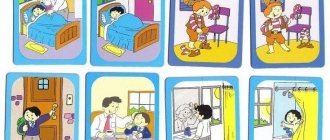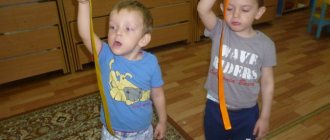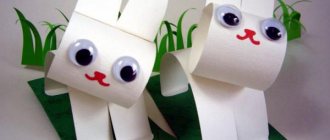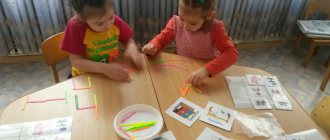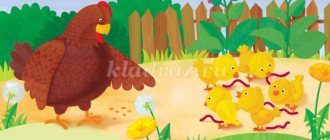Long-term planning of construction games in the first junior group.
September
1 week Kindergarten.
No. 1 “House for a cockerel.”
Draw children's attention to building materials and their design capabilities.
Karpukhina N.A., p. 176
Week 2 Autumn. Natural phenomena.
No. 2 “House for the dog.”
Continue to introduce the constructive capabilities of building materials, help children keep their attention on buildings and promote verbal expression of emotions.
Karpukhina N.A., p. 176
Week 3 Vegetable garden. Vegetables.
No. 3 “House for a bunny.”
Learn to place bricks end to end, perform basic actions with identical parts. Encourage children to create different houses.
Karpukhina N.A., p. 176-177
Week 4 Garden. Fruits.
No. 4 “Chair for Katya.”
Introduce children to the cube. Develop thinking and memory. Cultivate accuracy and perseverance.
Karpukhina N.A., p. 177
October
1 week Where did the bread come from?
No. 5 “Tower of two blue cubes.”
Learn to build a tower. Encourage children to name the color blue. Develop speech activity.
Karpukhina N.A., p. 178
Week 2 Forest. Mushrooms. Berries.
No. 5 “Tower of two blue cubes.”
Learn to build two towers of different colors. Develop speech activity. Strengthen the ability to apply details, increasing the height of the building.
Karpukhina N.A., p. 178
Week 3 Wild animals and their young.
No. 7 “Path for a car.”
Learn how to use building materials correctly. Encourage creating a variety of paths. Develop speech activity.
Karpukhina N.A., p. 182
Week 4 Domestic animals and their young.
No. 8 “Table and chair made of yellow cubes and bricks.”
Learn to use two types of parts at the same time - cubes and bricks. Fix the names of the parts. Develop the ability to build according to a model.
Karpukhina N.A., p. 180
November
1 week Poultry and their young.
No. 9 “A green table and two yellow chairs.”
Learn to consistently carry out constructions, controlling your actions. Combine buildings according to the meaning of the plot. Foster a desire to play with buildings.
Karpukhina N.A., p. 180
Week 2 Late autumn.
No. 10 “Multi-colored path.”
Learn to use building materials correctly, placing brick to brick, placing them on a wide surface. Encourage creating a variety of paths.
Karpukhina N.A., p. 182
Week 3 Man.
No. 11 “Independent design”.
Learn to independently choose a theme for design, details. Strengthen the ability to play with buildings. Cultivate positive relationships among children.
Week 4 Family.
No. 12 “Ladder”.
Learn to highlight the details of a building and play with the building. Practice constructing ladders consisting of six cubes. Foster a desire to build together.
Week 5 Home Furniture.
No. 13 “Table and chair of different colors.”
Learn to choose your own color. Develop construction skills. Cultivate perseverance and attentiveness.
Karpukhina N.A., p. 173
December
1 week Acquaintance with folk traditions and culture.
No. 14 “Narrow yellow path.”
Encourage children to build. Develop speech activity. Recognize and name the color yellow.
Karpukhina N.A., p. 182
Week 2 Winter. Winter fun and entertainment.
No. 15 “The track and the ball are the same color.”
Learn to build according to a model, placing the parts evenly. Develop color perception. Cultivate perseverance.
Karpukhina N.A., p. 183
Week 3 Wintering birds.
No. 16 “Wide red carpet.”
Learn to use the technique of laying building parts on a wide edge. Develop color perception. Cultivate neatness and a desire to play with buildings.
Karpukhina N.A., p. 173
Week 4 New Year.
No. 17 “Independent design”.
Learn to choose your own theme for design. Develop the ability to play with buildings. Foster a desire to play together.
January
1 week Clothes.
No. 18 “Fence”.
Learn to use the technique of laying building parts on a long edge. Build according to a ready-made model. Cultivate perseverance.
Karpukhina N.A., p. 184
Week 2 Shoes.
No. 19 “A fence made of cubes and bricks.”
Improve children's skill in building a fence by alternating building parts. Develop memory and attention. Cultivate neatness.
Karpukhina N.A., p. 185
Week 3 Zoo.
No. 20 “Fence. Blue square + red square."
Learn to build according to your own design. Strengthen the ability to build a fence. Foster a desire to play with buildings.
Karpukhina N.A., p. 185
February
1 week Ground transport.
No. 21 "Small Car".
Introduce children to a new construction part - a plate. Develop thinking. Foster a desire to play with buildings.
Karpukhina N.A., p. 187
Week 2 Traffic rules.
No. 22 "Bus".
Strengthen the ability to superimpose parts on top of each other. Develop speech activity. Cultivate a friendly attitude towards each other.
Karpukhina N.A., p. 187
Week 3 Water and air transport.
No. 23 “Bus and Truck Model.”
Teach children to carry out constructions according to the teacher’s verbal explanation, looking only at the sample. Develop memory and thinking. Cultivate a desire to build on your own.
Karpukhina N.A., p. 188
Week 4 Defender of the Fatherland Day.
No. 24 "Train"
Strengthen children's skills in building vehicles. Form the concept of size and color. Cultivate a desire to review works and evaluate them.
Karpukhina N.A., p. 188
March
1 week Profession. Tools.
No. 25 “A bench for a nesting doll.”
Introduce children to a new activity with construction details - the simplest floors. Form activity in the process of work according to the model. Review works and evaluate them.
Karpukhina N.A., p. 189
Week 2 Mother's Day March 8th.
No. 26 “Big and small benches.”
Strengthen the ability to build a bench. Teach children to examine parts and play with buildings.
Karpukhina N.A., p. 189-190
Week 3 Spring.
No. 27 “Gate and fence.”
Teach to build according to the teacher’s model without explaining the construction technique. Develop logical thinking. Cultivate attention
Karpukhina N.A., p. 190
Week 4 Products.
No. 28 “Colorful buildings.”
Strengthen the skill of buildings made of bricks, plates, different in size and color. Develop the ability to communicate and help in the process of playing around with buildings. To promote the assimilation of word names for designating construction parts.
Karpukhina N.A., p. 190-191
Week 5 Dishes.
No. 29 “House with a roof.”
Introduce children to a new building part - a prism (roof). Learn to consistently carry out construction, controlling your actions. Improve the skill of applying and applying.
Karpukhina N.A., p. 192
April
1 week Our city. My street.
No. 30 “House with a roof 2.”
Continue introducing children to prisms. To promote understanding of the expression “put a roof on top.” Encourage to distinguish building parts by shape, size, color, name.
Karpukhina N.A., p. 192
Week 2 Cosmonautics Day.
No. 31 “House based on a model without display.”
To develop the ability to carry out buildings according to a model without demonstrating basic design techniques.
Develop the need to communicate with adults and peers. Foster a desire to create a variety of buildings.
Karpukhina N.A., p. 193
Week 3 Migratory birds.
No. 32 “House with a Window.”
Reinforce the skills children have acquired throughout the year. Teach children to complete simple buildings. Cultivate friendly relationships.
Karpukhina N.A., p. 193
Week 4 Pisces. Water world.
No. 33 “Garage doors”.
Learn to build according to a model. Develop the ability to evaluate your own work and the work of your comrades. Foster a desire to play with buildings.
May
Week 1 Victory Day.
No. 34 "Children's Town".
Learn how to build consistently. Apply the parts evenly. Foster respect for materials.
Week 2 Flowers (medicinal, indoor).
No. 35 “Independent design”.
Learn to choose your own theme for design. Develop the ability to play with buildings. Foster a desire to play together.
Week 3 Insects.
No. 36 “Independent design”.
Learn to choose your own theme for design. Develop the ability to play with buildings. Foster a desire to play together.
Week 4 Summer.
No. 37 “Independent design”.
Learn to choose your own theme for design. Develop the ability to play with buildings. Foster a desire to play together.
Card index of construction games (2nd group)
Card index of construction games
(2 - junior group)
Construction games:
“Building a house for a cat and dog”
Target:
Develop children's ability to build a house. Learn to build in the required sequence. Promote the formation of joint play.
Material: cubes and bricks, plates.
Progress of the game:
Look, it’s raining, and our puppy Bimka is wet, he’s sitting under a tree and shaking. He needs to build a warm house - a booth. The presenter offers to build a house for the dog. Children select the materials themselves and invent the house themselves.
Sample:
"Pen for Animals"
Target:
Learn to build from horizontally placed bricks. Foster careful handling of construction.
Material: bricks.
Progress of the game:
The presenter brings a set of plastic pets and offers to build a pen for them so that they do not run away. It must be built from bricks placed horizontally.
Sample:
"Gate for Aibolit car"
Target
: Learn to build a gate from two vertically standing bricks, on which another brick is placed.
Material: bricks
Progress of the game:
Attention, a tiger at the zoo is sick. The good doctor Aibolit is driving a car to cure a patient. You and I urgently need to build a gate for the car. Children offer their buildings.
"The doll has a housewarming party"
Target
: To consolidate the skills and abilities of working with building materials, teach them to play with buildings, and enrich the experience of children. Construction of furniture in various ways.
Material: cubes and bricks, plates. .
Progress of the game:
The presenter invites the children, with the help of an adult, to build furniture for dolls. Choose your own building material.
Sample:
"Ladder for the turtle"
Target:
Continue to teach children how to create buildings, placing parts on top of each other and placing them next to each other; recognize and name building materials and buildings.
Material: bricks and plates.
Progress of the game.
Children find a family of turtles. The presenter builds a pond in advance and invites the children to build a ladder so that the turtles get to the pond. The bricks must be stacked on top of each other.
Sample:
Consultation for parents
on the topic of:
“Routes of health and hardening.”
First of all, let’s make a reservation that by walking we will mean not just walking, children being outdoors in the yard, garden or playground, but going out with children outside of their yard, district, city for special pedagogical purposes.
Who doesn’t know a child’s great inclination towards travel and tourism? How many requests do you constantly hear from children to go somewhere for a walk? How excited is your son or daughter to go camping? Walking with parents and elders in the family brings a lot of joy to children!
Conducting a construction game in the second junior group “Furniture for toys”
Anastasia Zaikova
Conducting a construction game in the second junior group “Furniture for toys”
Summary of the construction game in the 2nd junior group “ Furniture for toys ”
.
Goal: To generate interest in building a sofa for toys from building material .
Tasks:
Educational: To develop the ability to achieve certain results, to encourage the examination of building materials - to consolidate the name, shape, size, to distinguish colors, to teach how to place bricks vertically, connecting them evenly with cubes. Developmental: To develop the desire to construct buildings , combining them according to the plot and playing out.
Educational: Cultivate a desire to help toys .
Material: building material for each child (10cm - 5cm)
;
small animal toys (10 cm)
Progress:
— Guys, Mishka was sitting at home alone and they came to visit him. Look who? hare, fox, dog, cat, wolf, etc. But Mishka has no furniture . There is nowhere to seat guests. Now he's upset . Guys, what can we do?
- Let us help build sofas for Mishka so that they have somewhere to sit. What are the names of pieces of furniture where you can relax? (bed, chair, armchair, sofa)
.
— That's right, to build furniture , we need building material . You see them all in front of you. What are these items called? (showing bricks, cubes, children's answers)
.
-But from these bricks and cubes we will build a comfortable sofa for our guests.
-First, let's make the back of the sofa out of bricks. The bricks need to be placed on the narrow short side, close to each other, so that our guests do not fall. (Installs one brick, next to another)
.
To make it convenient for the toys tightly, we will place a cube next to each brick. This is how the sofa turned out. To make the sofas beautiful, we will build them from bricks and cubes of different colors.
-And now you guys are building a sofa for the guests
Masha, what are you building ? How will you build ?
During the work, the teacher observes how the children build and explains.
- What a sofa Dasha built , the bricks are close together, even, the cubes are close to the bricks. It's comfortable for the bear to rest.
- Well done, now the little animals have sofas to sit on, now you can play with them, go to visit and see how beautiful your sofas and armchairs are.
— Guys, do you know the difference between a sofa and an armchair?
- Yes, our sofa is wider, look at yours, several animals can sit there, but our chair is smaller, narrower, only one guest can sit there.
Guys, tell me how you helped Mishka’s guests?
build for them ?
Yes, you built very comfortable sofas and armchairs for your guests.
- Yes, that’s right, now Mishka is happy with his friends. And he says thank you for helping him. He wants to give you portraits of his guests. (I hand out pictures of animals to the children)
